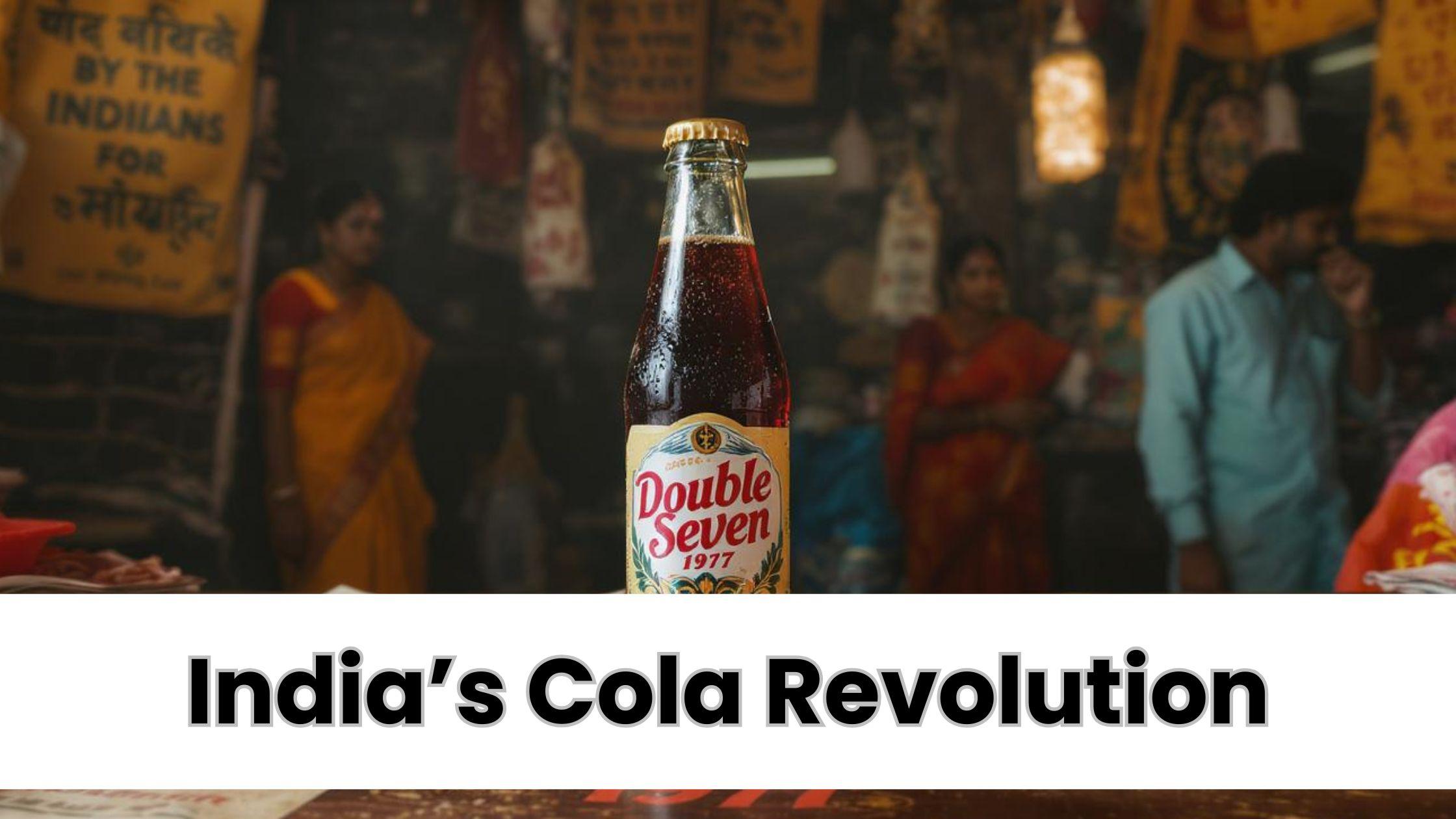Double Seven's Marketing Strategy: A Government-Driven Campaign

The launch of Double Seven in 1977 was not only a political and economic event but also a significant marketing experiment during India’s Cola Revolution. With Coca-Cola exiting India, the government aimed to promote a domestic alternative that could instill national pride and reduce dependence on foreign products. The marketing strategy for Double Seven was unique because it intertwined commercial objectives with political and cultural narratives. By positioning Double Seven as an Indian-made beverage, the government sought to appeal to patriotic sentiments while encouraging consumers to adopt a homegrown product.
Government’s Role in Marketing
Unlike typical corporate brands, Double Seven’s marketing campaigns were heavily influenced by government objectives. The government collaborated with advertising agencies to craft messages that highlighted nationalism, self-reliance, and India’s capability to produce world-class products. Television commercials, radio jingles, and print ads emphasized that purchasing Double Seven was not just a consumer choice but a patriotic act. The government’s involvement provided credibility and visibility, allowing the brand to reach a wide audience quickly.
Advertising Strategy and National Pride
Double Seven’s advertising campaigns were designed to resonate with Indian consumers’ sense of national pride. The slogan and imagery often showcased India’s independence and self-sufficiency, reminding citizens of the importance of supporting domestic products. Marketing materials highlighted that Double Seven was manufactured entirely in India, using local ingredients, which appealed to both urban and rural audiences. This approach differentiated Double Seven from foreign brands, which were increasingly associated with multinational corporate dominance.
Challenges in Communicating Value
While the marketing message emphasized patriotism, the brand faced challenges in convincing consumers of its quality. Many people compared Double Seven to Coca-Cola and other local colas, such as Thums Up and Campa Cola. Taste, carbonation, and product consistency were critical in shaping consumer perceptions, and some found Double Seven lacking compared to its competitors. The government-backed narrative of nationalism could not entirely offset concerns about flavor, which remained a primary driver of purchasing decisions.
Distribution and Market Reach
Marketing is only effective if the product reaches consumers. The government worked with Modern Food Industries to establish distribution channels for Double Seven. Bottling plants were set up in major cities, and efforts were made to penetrate smaller towns. Despite these efforts, logistical challenges such as limited refrigeration infrastructure and transportation difficulties hindered the brand’s ability to reach the entire market efficiently. Nevertheless, the marketing campaigns created awareness and curiosity, helping Double Seven establish an initial presence in a competitive market.
Promotional Campaigns and Public Engagement
Double Seven utilized promotional campaigns to engage the public directly. Street demonstrations, tasting events, and sponsorship of cultural programs were part of the marketing strategy. The campaigns often reinforced the brand’s association with Indian nationalism, highlighting the symbolic importance of choosing a local product over a foreign one. Schools, colleges, and public events were targeted to increase visibility among younger consumers, positioning Double Seven as a beverage that represented both taste and national pride.
Comparison with Private Competitors
Private cola brands like Thums Up and Campa Cola had a significant advantage over Double Seven. These brands relied on aggressive marketing techniques, emphasizing taste, adventure, and lifestyle, which appealed strongly to the youth. Double Seven’s government-backed approach, while effective in generating awareness, lacked the dynamic and consumer-centric messaging needed to create strong emotional connections. This contrast highlighted the challenge of using political and nationalistic messaging as the core of a marketing strategy.
Consumer Perception and Brand Loyalty
The government’s marketing efforts ensured that Double Seven was recognized across India, but building brand loyalty proved difficult. Consumers appreciated the patriotic aspect, but taste and quality influenced repeat purchases. While some consumers embraced Double Seven for its symbolic value, others returned to Thums Up or other local brands that offered more satisfying flavor experiences. This tension between ideological appeal and product satisfaction was central to Double Seven’s limited commercial success.
Media Strategy and Advertising Channels
Double Seven leveraged multiple media channels for promotion. Television and radio advertisements were prominent, taking advantage of state-controlled media to reach millions. Print media, including newspapers and magazines, highlighted the brand’s Indian origin and government support. These campaigns aimed to build trust and legitimacy in the absence of long-standing brand recognition. However, the heavy reliance on government media channels sometimes made the advertisements feel formal and less engaging than competitor campaigns, which were more creative and consumer-focused.
Cultural Relevance in Marketing
A unique aspect of Double Seven’s marketing was its cultural messaging. Ads often referenced Indian traditions, festivals, and patriotic themes, aiming to connect emotionally with consumers. This approach aligned with the broader goal of promoting self-reliance and reinforcing India’s identity during a period of political change. By tying the brand to cultural pride, the marketing strategy attempted to go beyond simple product promotion and establish Double Seven as a symbol of India’s Cola Revolution.
Lessons from Double Seven’s Marketing
The marketing strategy of Double Seven offers key lessons in integrating political and cultural messaging with commercial objectives. While government support provided visibility and credibility, long-term success depends on aligning messaging with consumer preferences, taste, and lifestyle. The balance between ideology and product quality is crucial; a nationalistic narrative alone cannot sustain a brand in a competitive market. Future Indian brands learned from Double Seven’s experience, emphasizing strong product positioning and consumer-focused campaigns alongside messages of local pride.
Impact on India’s Cola Market
Double Seven’s marketing campaign played a central role in shaping India’s cola market during the late 1970s. It demonstrated that consumer behavior could be influenced by political and cultural narratives, particularly when foreign brands exited the market. While the brand struggled to maintain loyalty, its presence encouraged other domestic cola companies to innovate and refine marketing strategies. The Cola Revolution that followed Coca-Cola’s exit was defined not just by new products but also by the innovative ways these products were promoted to resonate with Indian consumers.
Read Full Article : https://bizinfopro.com/news/marketing-news/indias-cola-revolution-how-double-seven-replaced-coca-cola/
About Us : BizInfoPro is a modern business publication designed to inform, inspire, and empower decision-makers, entrepreneurs, and forward-thinking professionals. With a focus on practical insights and in‑depth analysis, it explores the evolving landscape of global business—covering emerging markets, industry innovations, strategic growth opportunities, and actionable content that supports smarter decision‑making.
- Vibnix Blog
- Politics
- News
- Liberia News
- Entertainment
- Technology
- EĞİTİM BİLGİLERİ
- Art
- Causes
- Crafts
- Dance
- Drinks
- Film
- Fitness
- Food
- Oyunlar
- Gardening
- Health
- Home
- Literature
- Music
- Networking
- Other
- Party
- Religion
- Shopping
- Sports
- Theater
- Wellness



